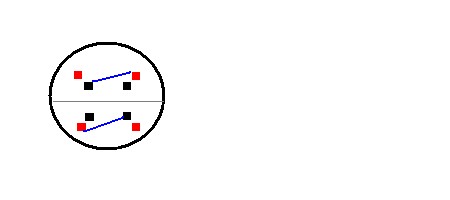I have a driver with QVC 1.4 coils and I had someone else wire it up for me. It's done properly, but for my own information I'd like to know what configurations are available. I know there is more than 3 ways to wire this. I'm looking for diagrams that show wiring in various ways and what the impedence will be. Any help would be greatly appreciate.
Use the parallel and series calculators on this site. You should think of a QVC sub as equivalent to a DVC but with more flexiblility of final impedance than a DVC woofer has. Wiring configurations must be of equal pairing so that each set of coils arrives to the same impedance as every other pairing of coils on that woofer. A QVC woofer can sometimes prove to be an advantage over SVC or DVC in the case where multiple subs are to be connected together on one single power supply. You have to bear in mind the total number of these subs you plan to connect together as well as how you are going to power them before deciding how to wire the coils together.
In that manner, you first consider what you can do with a pair of 1.4 ohm coils. And https://www.the12volt.com/caraudio/boxcalcs.asp provides the tools for the math. To start with: coils 1 and 2 in series, 3 and 4 in series, then the pairs paralleled = 1.4 ohms.
You should post up if using one or more of these subs, and amplifier(s) to be used. But for your own figuring, I suggest creating simple block diagrams of each possible configuration, labeling the polarity of every terminal and keeping each diagram the same format in respect to all others you draw.
This is an illustration of how you would look at a quad sub as a DVC sub. The wiring in this pic is coils 1 and 2 in series, and likewise with 3 and 4. Each half, then, amounts to 2.8 ohms.

Use the calculators to find if you should link top half to bottom half in parallel or in series, dependent upon your final impedance desire. To link top half to bottom (per illustration) in parallel, connect one pos terminal to one pos term, and likewise with neg. The simplest series wiring is coil-to-coil, in to pos terminal and out of neg term of each coil.
This could be a 1.4 ohm sub or a 5.6 ohm sub. (Considering relevant final impedances, that is, because all coils in parallel amounts to a very low impedance). When you have looked at every possible configuration you will realize that the final impedance possibilities are less than you think. When figuring these possibilities, you will find that oftentimes a parallel/series scheme arrives to the same final impedance as a series/parallel scheme.

-------------
Build the box so that it performs well in the worst case scenario and, in return, it will reward you at all times.
think of it as a pair of dual 1.4's.
parallel/parallel for .35
series/parallel for 1.4
series/series for 5.2
.35 ohms per sub could prove to be a usable impedance if the setup consisted of three subs and it was necessary to net 1 ohm. In this case, the parallel-wired subs are linked together in series to get that final 1 ohm impedance.

Other than a reason like this, choose coils in series / subs in parallel whenever there is a choice.
Using multiple subs follows the same base rules as dividing coils into evenly wired sets: each sub shall have the same impedance as all other subs in the group. So if you have two subs series-wired to 5.6 ohms each, they could be paralleled to make a 2.8 ohm load on the amp. Pic below shows the two subs wired together in parallel:

A series/parallel wired QVC with a net impedance of 1.4 ohms could be paralleled with another of the same to make .7 ohms. That's pushing the impedance floor if the amp can handle that low of a load for competing.

-------------
Build the box so that it performs well in the worst case scenario and, in return, it will reward you at all times.




